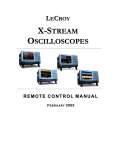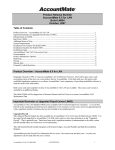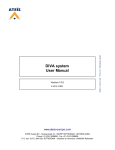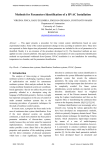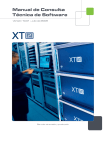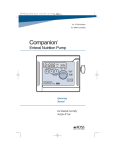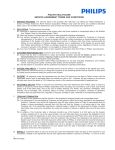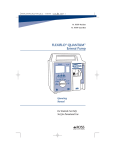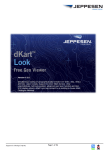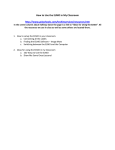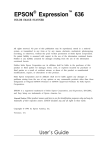Download NSF Workshop 2013 Proceeding - MIS team
Transcript
NSF WORKSHOP Development and Application of Online Medical Imaging Education Sponsored by NSF Grant DUE1022750 Principal Investigator: Weizhao Zhao, Ph.D. College of Engineering, University of Miami 1251 Memorial Drive, Coral Gables, FL 33146 August 16th, 2013 NSF 1022750 National Workshop McArthur-Annex Building, Room 202 College of Engineering, University of Miami 1251 Memorial Drive, Coral Gables, FL 33146 August 16th, 2013 (8:30 am – 5:00 pm) Final Program 8:00am Breakfast 8:30 am Registration, Introduction, Picture 9:00 am Invited Presentation: Web-Based Interactive Computer Simulation and Animation for Engineering Education, Ning Fang, Utah State University 9:30 am Medical Imaging Education by Online Animation and Simulation, Weizhao Zhao, University of Miami 10:00 am Medical Imaging Teaching Software: Ultrasound Imaging and Image Processing, Ricardo Castellanos, Diego Pava, Nurgun Erdol and William Rhodes, Florida Atlantic University 10:20 am Web Based Interactive Medical Imaging Application for Teaching Nuclear Medicine, Senait Debebe, Ruchir Bhatt, and Anthony McGoron, Florida International University 10:40 am Evaluation STEM Initiatives, Ann Bessell, University of Miami 11:00 am Discussion in THREE groups lead by PIs of FAU, FIU and UM, scribed by one participating scholar: Current medical imaging curriculum, teaching strategies, resources, and plans 12:15 pm Summary presentation of each group presented by a participating scholar 12:30 pm Lunch break 1:30 pm Tutorial for the developed MITS/DATS system 5:00 pm Conclusion Table of Contents Page 1 2 Invited Presentation: Web-Based Interactive Computer Simulation and Animation for Engineering Education, Ning Fang, Utah State University Medical Imaging Education by Online Animation and Simulation, Weizhao Zhao, University of Miami 1 15 Medical Imaging Teaching Software: Ultrasound Imaging and Image 3 Processing, Ricardo Castellanos, Diego Pava, Nurgun Erdol and William 30 Rhodes, Florida Atlantic University Web Based Interactive Medical Imaging Application for Teaching Nuclear 4 Medicine, Senait Debebe, Ruchir Bhatt, and Anthony McGoron, Florida 33 International University 5 Evaluation STEM Initiatives, Ann Bessell, University of Miami 37 6 Tutorial for the developed MITS/DATS system 45 7 MITS/DATS User Manual 72 Web-Based Interactive Computer Simulation and Animation for Engineering Education Ning Fang Department of Engineering Education College of Engineering Utah State University August 16, 2013 Outline 1. My background 2. NSF TUES program 3. Web-based interactive computer simulation and animation (CSA) – a critical review 4. Demos of web-based interactive CSA learning modules 5. Concluding remarks 1. My Background • Mechanical engineering (PhD in 1994, MS in 1988, BS in 1984) • Research interest: technology-enhanced gy learningg (clickers, tablet PCs, computer simulation and animation, intelligent tutoring systems, .…..) • Associate professor in the Department of Engineering Education at Utah State University 1 –1 Department of Engineering Education at Utah State University • Within the College of Engineering http://eed.usu.edu/ • Teach: 2nd year foundational engineering courses (Statics, Dynamics, Strength of Materials, Electrical Circuits, Computer-Aided Design, etc.)) Design etc • Research: Pedagogical research in engineering education PhD in Engineering Education program: one of the only three programs in the nation 12 PhD students (these students have MS/BS in engineering and are interested in educational research) NSF/DUE STEM Programs That I Was Involved • Transforming Undergraduate Education in Science, Technology, Engineering and Mathematics (TUES) Program (formerly CCLI program) that aims to improve undergraduate education in STEM disciplines. • Science, Technology, Engineering, and Mathematics Talent Expansion Program (STEP) that aims to improve the recruitment and retention of STEM undergraduates. • NSF Scholarships in Science, Technology, Engineering, and Mathematics (S-STEM) Program that provides scholarships to STEM undergraduates. • Advanced Technological Education (ATE) Program that aims to improve technology education in community colleges. 2. NSF TUES Program The vision of the TUES program is excellent STEM education for all undergraduate students, especially providing “transformative” learning experiences for students. students TUES Program Solicitation NSF 10-544 2 Most Up-to-Date CAUSE (Catalyzing Advances in Undergraduate STEM Education) is an NSF-wide investment that incorporates funding from established programs in the EHR directorate and other NSF directorates funded though the Research and Related Activities (R&RA) account. It is created by consolidating three Division of Undergraduate Education (DUE) programs: STEM Talent Expansion Program (STEP), Widening Implementation and Demonstration of Evidence- based Reforms (WIDER), and Transforming Undergraduate Education in STEM (TUES); several R&RA programs: BIO’s Transforming Undergraduate Biology Education (TUBE); ENG’s Research in Engineering Education and Nanotechnology Undergraduate Education (NUE); GEO’s Geosciences Education and Opportunities for Enhancing Diversity in the Geosciences (OEDG); and the cross-NSF program, Climate Change Education (CCE). FY 2014 NSF Budget Request to Congress TUES Program • Creating Learning Materials and Strategies Ex: web-based, interactive learning modules Ex: learning materials for mobile learning (iphone, ipad,…) • Implementing l i New Instructional i l Strategies i Ex: Peer-led guided inquiry Ex: Collaborative problem-based learning • Developing Faculty Expertise Ex: faculty development workshops Ex: virtual community of practices TUES Program (Continued) • Assessing and Evaluating Student Achievement Ex: assessment of students’ self-regulated learning skills Ex: assessment of students’ problem-solving skills • Conducting Research on Undergraduate STEM Education Ex: How do students learn foundational engineering concepts? Ex: What factors critically affect student retention? Ex: How to best design wed-based learning materials to optimize student learning outcomes, given diverse student populations (gender, learning styles, cultural background, … ) 3 Three Types • Type I: $200 K, 2-3 years, typically a single institution • Type T II: II up to t $600K, $600K 2-4 2 4 years, multiple lti l institutions i tit ti • Type III: up to $5M, over 5 years, multiple institutions Key Points In addition to excellent project ideas, implementation and evaluation plans, the project should: • Provide “transformative” transformative learning experiences for students. • Broadly disseminate project results to facilitate the adoption /adaption at peer institutions. 3. Web-Based Interactive Computer Simulation and Animation (CSA) – A Critical Review 4 Advantages of Computer Simulation and Animation (CSA) • Properly designed CSA helps improve students’ spatial abstract thinking skills by enabling students to visualize g g phenomena. p various science and engineering • Particularly attractive to many contemporary tech-savvy students as it promotes active and collaborative learning, and can be easily and widely adopted at both formal and informal education sites with no requirement for expensive physical facilities and instrumentations. Examples of NSF-Funded CSA Projects Project title Institution Development of Virtual CNC Machine Tools and Web-Based Machining Process Simulation and Learning Missouri University of Science and Technology An Inquiry-Based Simulation Learning Environment for the Ecology Hampshire College of Forest Growth Education Research Grant: Encouraging Students to Pursue Undergraduate Degrees in STEM Fields by Exposing them to Fundamental STEM Paradigms via Interactive Visual Arts Modules Morehouse College Introduction of Simulation Learning and Optimization to Support Engineering Design University of Illinois at Urbana-Champaign DIYModeling -- Do It Yourself Modeling and Simulation for STEM Learning Texas Southern University Modernizing the Undergraduate Power Engineering Curriculum with Missouri University of Real-Time Digital Simulation Science and Technology Interactive Simulation for Teaching Engineering Economics Rowan University Purpose of Literature Review Purpose: understand the current status of design and implementation of computer simulation and animation (CSA) programs/modules Scope: limited in foundational engineering mechanics courses: Statics, Dynamics, Engineering Mechanics, Strength of Materials; and several high school physics/mechanics 5 An Example Study An animated motorcycle module (Stanley, 2008): Why does the acceleration vector change direction and magnitude as it moves along the trajectory? Study Characteristics • Student learning outcomes • Sample size of study • Area of study • Authoring software • Proprietary • Mathematical equations • User controls • Other media • Experimental design • Data collection Results 6 Results (Continued) 7 8 Suggestions Design of CSA programs/modules: • More animation controls • Diverse representations of information • Free web browser plug-ins • Mathematic equations • “Copy & Paste” Assessment of student learning outcomes: • Random assignments • Control group, pre and post tests • Diverse methods of data collection and more performance tests 4. Demos of Web-Based Interactive CSA Learning Modules • TUES Type 2 project “Improving Students’ Problem-Solving in Engineering Dynamics Through Interactive Web-based Simulation and Animation Modules” (2011-2015) • Phase I (1.5 years): Develop a unique set of CSA modules for both particle and rigid-body dynamics • Phase II (2.5 years): Assess the effectiveness of the developed CSA modules using the quasi-experimental research design method: control group and treatment group. Engineering Dynamics • High-enrollment and high-impact, core engineering course that nearly all mechanical, civil, and aerospace engineering students are required to take. • Covering a broad spectrum of foundational concepts and principles, such as motion, force and acceleration, work and energy, impulse and momentum, and vibration. • One of the most difficult engineering courses to succeed in. In the Fundamentals of Engineering examination in 2009, the national average score for the Engineering Dynamics exam was only 53%. 9 Challenges of Student Learning in Dynamics • Spatial abstract thinking and reasoning skills to correctly understand what physically happens in a dynamics phenomenon and to identify correct dynamics concepts and principles associated with th t particular that ti l phenomenon. h • Analytical and mathematical modeling skills to help students translate their physical understanding into mathematical equations that accurately explain and describe why that particular dynamics phenomenon occurs and how it evolves. Features of the New CSA Learning Modules • Integrates visualization with mathematical modeling • Interactive computer graphical user interface allows students to vary inputs and see how the numerical numbers in mathematical equations change, simultaneously and dynamically, as a physical object moves in a space • Web-based and stand-alone computer software program. Examples of the CSA Learning Modules 10 Demos of web-based interactive CSA learning modules Research Question To what extent the developed CSA modules improve students’ stude ts conceptual co ceptua as well we as procedural p ocedu a knowledge ow edge (skills) (s s) of engineering dynamics? Research Design Quasi-experimental research design, surveys, and interviews Learning gain = Post-test score (%) - Pre-test score (%) 100 (%) - Pre-test score (%) 11 Student Participants Control semester: 86 students from three departments: mechanical and aerospace engineering, civil and environmental engineering, biological engineering Treatment semester: 94 students from the above three engineering departments Preliminary Results 100% 100% 80% 80% 60% 60% 40% 40% Pretest Posttest 20% Pretest Posttest 20% 0% 0% 0 2 4 6 0 2 4 6 CSA Module 2 • • Control semester: Class-average learning gain 16% Treatment semester: Class-average learning gain 62% Continued 90% 100% 90% 80% 70% 60% 50% 40% 30% 20% 10% 0% 80% 70% 60% 50% 40% 30% 20% Pre 10% Post 0% 0 1 2 3 4 5 6 Pre 0 1 2 3 Post 4 5 6 CSA Module 4 • • Control semester: Class-average learning gain 21% Treatment semester: Class-average learning gain 69% 12 Student Comments • • • • • “When visual and math come together, see and understand much better.” “I was able to see the math laid out in front of me. Then I can see the physics as it moves in real life. This links the two. two.” “They helped me see that happens and see why.” “I could see how different factors changed the simulation and in what way.” “They helped me visualize the relationships of how the mathematics changes when the calculations are altered.” Student Comments • • • • • • “Seeing physical demonstrations definitely helps to understand what the math is describing.” “They help me connect what is happening conceptually to mathematically.” “It helped me visualize what was happening & see how the related.” physics and mathematics were related. “The computer simulation made it possible to visualize some concepts that were not as easy to see just on paper.” “It was nice to “instantly” see if my intuition was correct or not.” “For some of the problems my institution was incorrect and the computer simulations helped illustrate the mathematical proof of the problem.” 5. Concluding Remarks • If designed properly, web-based interactive computer simulation and animation (CSA) programs/modules can improve student learning. • When designing CSA programs/modules, it is suggested t d to t consider: id More animation controls Diverse representations of information Free web browser plug-ins Mathematic equations 13 Thanks for Your Attention! 14 Medical Imaging Education by Online Animation and Simulation Weizhao Zhao, Ph.D. Department of Biomedical Engineering University of Miami, Coral Gables, Florida Background: Facts • BME education has developed as an interdisciplinary engineering training area in the last 30 years. • Medical Imaging is a required training area in BME and almost any health care related major, e.g., medical physics, health science. • Medical Imaging techniques are applied in clinical and research laboratories on a daily basis. • Medical Imaging instrument is usually unavailable (even available, it is usually not accessible). Background: Facts BME Undergraduate Enrollment in USA Colleges (2012) 26620 24067 25000 21722 20062 20000 18317 15892 16671 14677 15000 13213 10946 9324 10000 6340 7165 5000 2000 2001 2002 2003 2004 2005 2006 2007 2008 2009 2010 2011 2012 Year http://www.asee.org/papers-and-publications/publications/11-47.pdf 15 Background: Facts BME Programs, Medical Imaging Courses in USA Colleges (2010) 120 119 90 80 68 60 51 30 15 0 BME Program w/Grad Img Course w/Under Img Course w/Online Doc. w/Online Simu. http://mis.eng.miami.edu/survey Background: Resource Background: Resource EHR Directorate Graduate Education (DGE) Research on Learning in Formal and Informal Settings (DRL) Undergraduate Education (DUE) Human Resource Development (HRD) ENG Directorate Chemical, Bioengineering Environmental, and Transport Systems (CBET) Civil, Mechanical and Manufacturing Innovation (CMMI) Electrical, Communications and Cyber Systems (ECCS) Engineering Education and Centers (EEC) Emerging Frontiers in Research and Innovation (EFRI) Industrial Innovation and Partnerships (IIP) 16 History: Success NSF CCLI DUE0127290 (2001-2004) “Proof of Concept” NSF CCLI DUE0632752 (2006-2009) “Build a Prototype” NSF TUES DUE1022750 (2010-2014, Current) “Expansion Development” NSF DUE 1022750 Florida Atlantic University Florida International University University of Miami Collaborative Development and Application of Distributable, Internet Accessible, Interactive Medical Imaging Teaching Software (MITS) and Dynamic Assessment Tracking System (DATS) Motivation • You hear, you forget. • You see, you remember. • You do, you understand. • What do you see and what do you do? • A picture is worth a thousand words: you see! • A moving picture is even better: you see more! • An interactive moving picture is better than a simple moving pictures: you do too! 17 Hypothesis Web-based interactive teaching model increases student learning gain in the field of medical imaging education, particularly for biomedical engineering students. Objective • Develop an online learning environment to help successfully deliver medical imaging curriculum MITS: Medical Imaging Teaching Software • Develop an online tracking platform to evaluate teaching effectiveness and assess student learning gain DATS: Dynamic Assessment Tracking System Curriculum in UM’s BME Image Reconstruction BME520 Med Img System BME330 Foundation of Med Img BME629 Adv Med Img BME521 Med Img Appl Physics Required (Junior) Image Processing Adv Recon. and Research Graduate Elective (Senior or Graduate) 18 MITS: The Design Course Modality Module Component MITS: Online Interactive Learning MITS: teaching tool and learning environment MITS: Dynamically Generated Webpage Component Modality Module 19 Animation and Simulation General Radiation Characteristic Radiation Animation and Simulation Animation Example Either you can explain the following equation and ask student to write codes to simulate CT projection… ∑ f (x ⋅ cosθ + y ⋅ sin θ ,− x ⋅ sin θ + y ⋅ cosθ ) p ( x ' ,θ ) = verticle axis = ∑ f (x ⋅ cosθ + y ⋅ sin θ , y ') ∀θ y' And explain the following equation and ask students to write codes to simulate CT reconstruction… g ( x, y ) = ∑ p( x' ,θ ) = ∑ p( x ⋅ cos θ + y ⋅ sin θ ,θ ) θ OR ∀θ θ Animation and Simulation 20 Animation and Simulation Animation and Simulation DATS: Online Assessment Database Pre-Modality Test (4~5 concept questions) Pre-Module Test (1~2 concept questions) Module 1 Web-based Module Assessment Post-Module Test (1~2 concept questions) Pre-Module Test (1~2 concept questions) Module 2 Post-Module Test (1~2 concept questions) MODALITY 1 Post-Modality Test (10~20 questions) Modality Teaching Learning Assessment Course Teaching Learning Evaluation Final Review Test (40~50 questions) 21 DATS: Module Information DATS: Manager of MITS Application: Hybrid Approach Web-Modality Pre-test Web-Module Pre-quiz Web-Reading/Practicing Web-Module Post-quiz Classroom Lecture (Module) Class Homework/Project Web-Modality Post-test 22 Animation and Simulation: X-ray Modality: ¾X-Ray Tube’s working principle ¾X-Ray Tube’s emission spectrum ¾Inner shell ionization ¾Bremsstrahlung radiation ¾Compton Scattering ¾Half Value Layer ¾Attenuation ¾X-ray Geometry Animation and Simulation: CT Modality: ¾Pen-beam projection ¾Fan-beam projection ¾Back projection by degree in Radon domain ¾Back projection by Cartesian coordinate ¾Downloadable CT Simulation ¾Numerical reconstruction Animation and Simulation: MRI Modality: ¾Precession ¾Larmor frequency and RF pulse ¾MRI Relaxation ¾Downloadable FID Simulation ¾Downloadable Reconstruction Simulation 23 Animation and Simulation: Nuclear Medicine Modalities: ¾Radioactive decay through materials ¾How PET works ¾How SPECT works ¾Radionuclide half-life ¾Coincidence Sampling ¾PET demonstration ¾Reconstruction demonstration ¾To be uploaded animations by FIU ¾To be uploaded simulations by FIU Animation and Simulation: Ultrasound Imaging Modality: ¾A-mode Ultrasound ¾M-mode Ultrasound ¾B-mode Ultrasound ¾Doppler Effect ¾To be uploaded animations by FAU ¾To be uploaded simulations by FAU Collaboration: “Users” • Contacted: ¾ ¾ ¾ ¾ ¾ ¾ ¾ ¾ ¾ ¾ University of Valencia (EE), Spain University Pompeu Fabra in Barcelona (BME), Spain IIT Roorkee (ECE), India Ariel University (MP), Isaerel University of Western Ontario (ECE), Canada Medical School Athens, Greece Università degli Studi di Milano (Rad), Italy Baylor College of Medicine (MI), TX Duke University (CoE), NC DeVry University (BMET), CA ¾ Rose-Hulman Institute of Technology (MP), NJ ¾ Wentworth Institute of Technology (BME), MA ¾ Catholic University of America (ECE/BME), DC ¾ Prairie View A&M University (PHY/BME), TX ¾ University of North Carolina (BME), NC ¾ Broward College (HS), FL • Participating ¾ Florida Atlantic University ¾ Florida International University ¾ University of Miami 24 Application: “Protocols” BME330: Foundation of Medical Imaging ¾Primary teaching material: Textbook, Instructor’s handout ¾MITS/DATS system: Reference material, volunteer ¾Pre/Post test/quiz: Extra credits BME520: Medical Imaging System ¾Primary teaching material: Textbook, No handout ¾MITS/DATS system: Hybrid with textbook to serve as handout material, volunteer ¾Pre/Post test/quiz: for review only, NO extra credits Results Subjective perception information Results Factual information 214 students (154 undergraduates) took medical imaging courses For modality X-ray and CT (pre/post test) Pre (n=23) Post (n=21) GPA 3.42±0.34 1 3.46±0.44 All Prob. 82±9% 2 89±8% Concept Prob. 76±5% 3 91±6% 1: p < 0.7 2: p < 0.1 3: p < 0.05 Projects 82±5% 3 90±6% 25 Results Learning Gain Result: Concept understanding quiz (BME520) Basic Concepts of Medical Imaging 2011 (Before) Basic Concepts of Medical Imaging 2011 (After) Wrong 25 25 Correct Answers 15 10 Correct 15 10 5 5 0 0 2 3 4 5 6 7 8 9 1 10 11 12 13 14 15 16 17 2 3 4 5 6 7 8 9 10 11 12 12 14 15 16 17 Concepts Concepts Learning Gain (2011): LG = (post-pre)/(100-pre) = 0.36 ± 0.28 Results Subjective perception Result: Survey from classes (BME330/520) Junior (Required Course) Rating (1: Lowest 5: Highest) Subjective Perception Senior (Tech Eelective) 5 4 3 2 g O ve ra ll R di n at in g ed Fo cu s rs ta n Un de ce En ha n En gi ne er in g lfSt ud y In te re st Se te ul a ita bl e Sim Su e bo ok Te xt fa c In te r ew ar e Be yo nd C ou rs le dg e In te gr at io n 1 Kn ow 1 Apparent subjective perception “disparity” between classes Results Engagement Result: Time used on MITS (BME330/520) Engagement on Courseware Junior (Required Course) 35 Senior (Tech Eelective) 30 Time (minute) Answers Wrong 20 20 25 20 15 10 5 0 First Time Each Time Time on Simulations Apparent subjective perception “disparity” between classes 26 Results Grade Impact Result: Midterm/Final exam (BME330) 100.0 112 90.0 80.0 73.5 69.2 70.0 121 68.9 63.0 60.0 50.0 40.0 30.0 20.0 10.0 0.0 Mid Final 112: 73.5+/-16 and 68.9+/-14 (N=12), lowest grade B (n=4) 121: 69.2+/-22 and 63.0+/-27 (N=24), lowest grade F (n=1), D (n=1), C (n=3) Results Comments Result: Open end survey (BME330/520) Summary: ¾Animations of the underlying physics behind modalities… ¾Organized well and provided visualization… ¾Good summary for class review… ¾Remote accessible, self-paced… ¾Practice test/quiz help review… ¾Format is not consistent… ¾Index is not clear… ¾Pre/post quiz does not match content/class material… ¾Class test questions are too difficult and some not relevant… ¾Too much text… ¾Can you put the website on Blackboard… Conclusion • MITS provides an Internet accessible, interactive, module based teaching tool and learning environment • DATS manages MITS through a database platform, provides quick feedback for teaching efficiency and assesses student learning gain dynamically 27 Future Work • Seeking for collaboration to apply the system under different settings, such as BME, ECE, HS, PHY, or other curricula. • Seeking for NSF proposal collaborators: Medical Imaging through CyberLearning • Seeking for collaborative research on Integration of Medical Imaging into Special Applications, e.g., Medical Physics program, Health Science program Acknowledgement NSF CCLI DUE0127290 (2002-2004), “Proof of a Concept” NSF CCLI DUE0632752 (2006-2009), “Build a Prototype” NSF CCLI DUE1022750 (2010-2014), “Expansion Development” External Advisory Committee Dr. Thomas Harris, Director NSF EEC Dept. of Biomedical Engineering, Vanderbilt University Dr. Autar Kaw, ASEE Distinguished Scholar 2011, US Professors of the Year, 2012 Dept. of Mechanical Engineering, University of South Florida Graduate Students David Wu, Aditya Dixie, Chunyan Wu, Alon Mozes, Jack Lu, Qian Shen, Xiping Li, Decho Surangsrirat, Wupeng Yin, Hairong Chen NSF CCLI/TUES Program Directors Dr. Russell L. Pimmel, Dr. Don L. Millard http://mis.eng.miami.edu 28 Questions? http://mis.eng.miami.edu 29 NSF National Workshop on Medical Imaging Teaching Software University of Miami – 16 August 2013 1 Florida Atlantic University Modules Ultrasound Imaging Image Processing Ricardo Castellanos Diego Pava Prof. Nurgun Erdol Prof. William Rhodes 2 Medical Imaging Course Testbeds Fa10 Florida Atlantic University - 10 students Sp12 Florida Atlantic University - 12 students Sp12 Universidad Javeriana - 30 students Sp13 Universidad Javeriana - 26 students Total of 78 students (all from engineering) 3 30 Course Text: Medical Imaging Signals and Systems by Prince & Links An excellent text for students with background in engineering and physics, but short on figures in certain areas: a good candidate for augmentation with animations. 4 Representative Examples 5 Ultrasound Imaging Presentation by Ricardo Castellanos (Ph.D. candidate in electrical engineering) 6 31 Image Processing for Medical Imaging Image Processing Innotool For Medical Imaging A Matlab-based teaching software package and tutorial Diego F. Pava Florida Atlantic University Presentation by Diego Pava (Ph.D. candidate in electrical engineering) 7 32 Senait A. Debebe, Ruchir Bhatt, Anthony J. McGoron Department of Biomedical Engineering , Florida International University, Miami, FL, U.S.A. Develop interactive medical imaging applications focused in Nuclear medicine Establish internet accessible applications Sharable, distributable and upgradable applications Increase students learning gain by conveying dynamic explanations. Flexible learning schedule to fit into the available class hours. I. 2 PET Simulation MATLAB® was used to simulate PET image reconstruction mechanism. Scattering and random coincidence effects were simulated by adding Gaussian and/or Poison noise. Radon transform was performed to generate sinogram of an image. Filtered Back Projection algorithm was used to reconstruct the original image 3 33 II. Tracer Kinetics Model The relationship among Input function (Plasma activity), Tissue response, model structure and rate constants was Illustrated using 3-compartmental models. MATLAB® GUIDE has been used to develop a user interface. Background MATLAB program has been used to implement: Ai = ⊗ Where Ai is the measured data by PET 4 © 1994-2000 Crump Institute for Molecular Imaging UCLA School of Medicine III. Reporter Gene Imaging Animation of PET reporter gene imaging was performed. Adobe® Flash® Professional CS5 was used together with to apply codes . ActionScript 3.0 5 IV. Coincidence detection Circuitry of PET coincidence detection, generation of single and multiple incidences are animated. Adobe® Flash® Professional CS5 was used. 6 Courtesy of : ‘The promise of Immuno-PET in Radioimmunotheraphy’ , J Nucl Med January 1, 2005 vol. 46 no. 1 34 V. Autoradiography Procedures and materials required to do Autoradiography is animated which is used determine the distribution of radioactivity. Adobe® Flash® Professional CS5 was used. 7 Copyright © 2010, InvivoPharm Inc Activities 1. Choose to add Gaussian and/or Poison noise Set STD value; Enter angle spacing between projection angle of Radon transform Adjust image reconstruction parameters ; filter type & cutoff frequency Help files provided 8 2. Activities Choose between models Click on input functions (PTACs) Enter estimated rate constant values (Ki) Observe the resulting TTACs 9 35 3. 10 Activities Step by step procedures are animated. Reporter gene injection and its route inside a liver cell is elaborated. Reporter probe interaction with expressed proteins/enzymes/r eceptors is shown. Start, forward and backward buttons are provided. Activities Start button to 4. start the animation Coincidence detection circuitry is animated Step by step explanation of signal generation Next button to go to the next step 11 Activities Start button to 5. start the animation Injection and distribution of radioisotope, and technique of autoradiograph is animated Step by step explanation materials and methods applied Next button to go 12 to the next step 36 EVALUATING STEM INITIATIVES p( x' , ) f x cos y sin , y' y' g ( x, y) p ( x cos j y sin j , j ) Ann G. Bessell, Ph.D. WHAT IS ? Beyond Science, Technology, Engineering and Math STEM education attempts to transform the typical professor-centered classroom by encouraging a curriculum that is driven by problem-solving, discovery, exploratory learning, and requires students to actively engage a situation in order to find its solution. STEM PIPELINE FROM 9TH GRADE TO BACHELOR’S DEGREE FOR LOWINCOME STUDENTS IN THE U.S. 10,000 Students in 6,600 of 10,000 the Bottom Students Earn a Income Quartile High School Start the 9th Grade Diploma (8,200 total) 3,860 of 10,000 Students Go to College 76 are Declared STEM Majors vs 800 total 710 of 10,000 Students Earn a Bachelor’s Degree 30 BA/BS in STEM Fields vs 400 3 37 THINK OUTSIDE THE BOX: PROBLEMS 1. Convert the following figure into a six by adding only one line. IX 2. Leave two squares in the following figure by removing just two lines. 8/15/2013 8/15/2013 THINK OUTSIDE THE BOX: SOLUTIONS 1. Convert the following figure into a six by adding only one line. SIX 2. Leave two squares in the following figure by removing just two lines. 8/15/2013 8/15/2013 10 ESSENTIAL STEM TEACHING PRACTICES 1. Believe in your students. Set high expectations for your students, challenge them to succeed, and believe that they will. 2.Transfer control of the learning process to the students. Develop new roles and rules that stress student responsibility.Then guide from the sidelines while keeping students on target with their direction and purpose. 3. Foster curiosity. Pose problems rather than answers and send students on a search for solutions. Use discrepant events to intrigue students and draw them into the problem. 4. Provide hands-on, experiential learning. Don’t be the oldfashioned sage on the stage. Learning through reflection and doing is compelling.When your students have their imagination piqued, give them opportunities to actually investigate multiple possible solutions to a problem, or to solve a mystery. 38 5. Increase collaboration among students. Get comfortable with teamwork. 6. Accept failure – both yours and the students – as a necessary part of learning and growing. That is, accept failure that accompanies taking a risk and experimenting, knowing that they might not get it right. 7. Be an inspiring leader and role model for your students. Be positive and enthusiastic about what students are learning and how they are learning it. 8. Accept some drawbacks. STEM education will improve student engagement, critical thinking skills, and workforce skills. But you’ll need to be flexible and ready to make some quick shifts in your thinking. 9. Evolve and grow as a learner. Develop your skills in facilitating (as opposed to dictating) so that students focus on learning how to think like a STEM professional. 10. Learn in community. Work with your colleagues to study effective ways of teaching STEM lessons. REASONS FOR EVALUATION Performance improvement Outcome assessment Program justification Accountability Program clarification Cost-effectiveness RESULTS-BASED ACCOUNTABILITY™ Results (or outcomes or goals) as "A condition of success for students, professors, program of study, or school." This can include some of the major junctures in a student’s education where they can continue on a trajectory toward success or fall back/fall through the cracks. Indicators (or benchmarks) which are the "what" that can be measured to help quantify the achievement of an outcome. Each program needs to identify the appropriate indicators for their program by answering the question "How would we recognize these outcomes in measureable terms?" Performance Measures. These are the metrics that will be used to measure how well a program, course, or career path is working. Each program needs to identify the appropriate metrics for their program by answering questions like "How much did we do?, How well did we do it?, What are the effects/gains for the participants?" 39 EVALUATION PLANNING Most STEM evaluation proposals ask for three elements but use different language: “Fidelity of Implementation” or just “fidelity” measures the extent to which the program activities have been accomplished. “Formative” or “process” evaluation provides midcourse corrections to Pis. “Summative” or “impact” evaluation summarizes the programs merit and worth. 1/1/11 THEORY OF PROGRAM CHANGE: “…a static, fixed, and mechanical cause-effect model where inputs lead to outputs, which produce outcomes and impacts… “Works well in simple situations of high certainty and high agreement about what to do. But such modeling has significant downsides and distorting effects in complex and dynamic situations where the [program] is emerging, evolving, and adapting.” MQP 2011 BASIC LOGIC MODEL 40 LOGIC MODELS 41 STRUCTURE OF A COLLABORATIVE Proposed structural design illustrating the dynamic relationship between a multidisciplinary teams and network collaborators. A = external universities, B = external research centers, C = independent researchers/labs, D = pharmaceutical companies/labs, E = governmental agencies/labs, F = clinical research support (bio-repositories, biostatistics, clinical research units, etc.) INPUTS Resources, contributions, investments that go into the project. Input indicators measure resources, contributions and investments such as: Staff Volunteers Funding Materials Facilities OUTPUTS Output indicators measure things such as the scope/size of activities, services, events, and products reaching the target population: Numbers of students served Number of simulations completed Number of courses Numbers of workshops 42 PROCESS INPUTS OUTPUTS UNPACKING THE BLACK TUBE Usability methods Cognitive interviews “Think Alouds” Focus Groups Satisfactions Challenges Successes Observations Surveys OUTCOMES Things project hopes to achieve; actual benefits, impact, or changes. Outcomes are expressed in terms of changes for individuals, groups, communities, institutions, and system : Knowledge, attitude, and skill changes Behavior changes Value changes Policy, procedural, and practice changes 43 CONSIDERING BP SUCCESS AT MULTIPLE LEVELS Level 1: Having access to the benefits of STEM knowledge Level 2: Having access to STEM knowledge Level 3: Studying STEM Level 4: Working in STEM areas Level 5: Generating STEM knowledge 11. ON A SCALE OF 1 TO 10, HOW SATISFIED ARE YOU WITH YOUR SIMULATION EXPERIENCE? 1 (lowest) 2 3 4 5 6 7 8 9 10 (highest) 0% 8 0% 0% 0% 10 9 (h ig he st ) 0% 6 0% 7 0% 4 0% 5 0% 2 1 (lo w es t) 0% 3 1. 2. 3. 4. 5. 6. 7. 8. 9. 10. BRIEFS AS A WAY TO DISSEMINATE BUSINESS PARTNERSHIPS TO ADVANCE STEM EDUCATION: Building a Bridge to Homegrown STEM Talent Focus on Teachers 44 MITS/DATS TUTORIAL Website: http://mis.eng.miami.edu/ Adobe Shockwave or Flush should be installed before use. 45 Start webpage Click here to get onto the main page MIS Website: http://mis.eng.miami.edu/module/mis.php 1. Home 2. User Login 4. Img Modalities 4. Img Modalities 3. Administrator login 2. User Login 1. Home Page: http://mis.eng.miami.edu/module/home.php 1.1. Self-Link 1.2. Other BME 1.3. Img Manufac 1.5. Announcement and contact 1.4. Design 46 1.2. Link to other BME: http://mis.eng.miami.edu/Files/SD2-1.pdf Link to Other BMEs 1.3 Link to Img Manufac: http://mis.eng.miami.edu/Files/SD3-1.pdf Link to Medical Imaging Manufactures 47 1.4. Design Outline: http://mis.eng.miami.edu/Files/SD5-1.pdf MITS Design Outline 2. Login : http://mis.eng.miami.edu/module/modality.php?modality=login 2.1. First time login 2.2. Normal login 48 1st time Login : http://mis.eng.miami.edu/module/modality.php?modality=flogin 2.1. set up user ID and password for future login 2.1. Other information for focused groups 3. Admin Login: http://mis.eng.miami.edu/admin/m.php 3. 1 3. 2 3. 3 3. 4 3. 5 3. Administrator login 49 3.1. Add Users Usr ID: (better specified) Any character sequence without space in between Line break for difference user ID Condition information for future data retrieval 3.2.1. User Management Check “Use Condition” can extract users meeting the conditions. Uncheck “Use Condition” will extract all previously registered users. 50 Check “Match Case” can extract specified users ignoring conditions. 3.2.2. User Management View Report Reset Delete 3.2.3. User Management View View specified user’s “engagement” with the system. 51 3.2.4. User Management Report Output specified user’s “performance” In each module. 3.2.5. User Management Reset When “reset” a user, user ID remains but the user must go through “first time” login to create password. 52 3.2.6. User Management Delete When “delete” a user, user ID and user performance information can be deleted individually. 3.3. Modality Management To allow user to access specified “Modalities” To determine the number of post-test questions for users. 53 3.4. Module Management To allow user to access specified “Modules” within each Modality 3.5. Change Password Administrator/Instructor’s Password should be changed at the first time login. 54 4. MIS Website: http://mis.eng.miami.edu/module/mis.php MRI X-ray CT Ultrasound Img Proc Tools PET 4.1. Hierarchical Design Course Graduate, undergraduate, etc. Modality Available, specified, etc. Module Hardware/software, physics, engineering, etc. Component Text, figure, animation, simulation, etc. 55 4.2. Learning Assessment Pre-Modality Test (4~5 concept questions) Pre-Module Test (1~2 concept questions) Module Assessment Module 1 Post-Module Test (1~2 concept questions) Pre-Module Test (1~2 concept questions) Module 2 Post-Module Test (1~2 concept questions) Modality Assessment MODALITY 1 Post-Modality Test (10~20 out of ~40 questions) Course Assessment Final Review Test (40~50 out of ~100 questions) 4.3. Example Modality Module Text component Fig component 56 4.3. Example Animation component 4.3. Example Downloadable Simulation component 57 Go through an Imaging Modality Step 1: Administrator Login Administrator login 58 Step 2: Create User Account Administrator login Log out when done Add user Step 3: User Login User login Or click any Imaging modality 59 Step 3: User Login First time login must go through this step! Step 4: User Information Password will be remembered by the system! 60 Step 5: Go through CT Modality: Pre-Modality Assessment Check student’s science/engineering background. Step 6: Go through CT Modality: Pre-Module 1 Assessment Check student’s science/engineering background for the current topic. System gives the correct answer. 61 Step 7: Go through CT Modality: Module 1 This module mainly uses slide presentation. Step 8: Go through CT Modality: Post-Module 1 Assessment System gives the correct answer. This post-quiz question is usually the key concept for the module. 62 Click Next to proceed to next module. Step 9: Go through CT Modality: Pre-Module 4 Assessment Step 10: Go through CT Modality: Module 4 This module presents some animations. This module presents some equations. 63 Step 11: Go through CT Modality: Module 4 (Projection) CT projection animations (pen-beam and fan-beam) can be played directly. Step 12: Go through CT Modality: Module 4 (Back Projection) CT back projection animations (coordinatebased and angle-based) can be played directly. 64 Step 13: Download Executable Simulation created by MatLab Simulation created by MatLab codes has been converted to executable applications. Step 14: Executable Simulation (FID) 65 Step 15: Executable Simulation (FID) Step 16: Executable Simulation (MRI) 66 Step 17: Executable Simulation (MRI) Step 18: Go through CT Modality: Post-Modality Assessment This box will always stay here when all modules are learned. Assess student’s learning gain after learning this modality. 67 Step 19: Go through CT Modality: Post-Modality Assessment Every question must be answered to completer the assessment. Deficits? Answers are not provided to user but to Instructor. Step 20: Track Student Performance Log out first Then administrator login 68 Step 20: Track Student Performance Go to User Management Step 21: Track Student Performance View provides report of User’s each “engagement” by clicking the user name on the left Select “View” to see User’s “engagement” with the system. 69 Step 22: Track Student Performance Performance on assessment questions for Pre-post Modality and Pre-post Module are reported here. Left column is user’s answers. Right column is correct answers. Left column is user’s answers. Right column is correct answers. Step 23: Track Student Performance Select “Report” to see User’s numerical data with the system. 70 Administrator is a “User” Modalities are “Parallel” Modules are “Sequential” User Manual is attached System will be updated continuously Correction and revision are welcome New development are very much welcome 71 Instruction to MITS/DATS online courseware MITS: DATS: Medical Imaging Teaching Software Dynamic Assessment Tracking System MITS/DATS is designed for medical imaging education as an online courseware that is particularly used under a hybrid teaching/learning environment. The courseware consists of five commonly used medical imaging modalities (X-ray, CT, MRI, PET, and Ultrasound) and commonly used image processing tools (under construction). Each imaging modality consists of six basic components to deliver knowledge to students, 1) text description, 2) figure/picture/image illustration, 3) interactive animation, 4) interactive simulation, 5) pre-post assessment and 6) library of medical imaging application (under construction). Each imaging modality in MITS contains several teaching modules (teaching/learning topics). DATS is a database under MySQL environment. DATS is the “manager” of MITS. DATS controls turning on/off modalities, modules, assessment questions and user enrollment. Home page: http://mis.eng.miami.edu/module/home.php, 72 On the home page, we provide Links to Other BME Program in USA (updated 2009) Links to Medical Imaging Manufactures (updated 2009) Links to Imaging Simulation Flow Charts (updated 2008) Announcement: updating news for MITS/DATS Intern Students: application for internship Participating Institution: application as a user-institution Faculty Workshop: application for attending NSF-funded workshop From the home page to the MITS page, either click the MIS Webpage or enter the MITS address http://mis.eng.miami.edu/module/mis.php see captured screen: Note that the MIS link is a webpage under the MITS/DATS home page 73 Login as Administrator/Instructor Go to the bottom of the page (home page or MIS page) Copyright © 2005 - 2010 MIS | MIS team | Contact | Medical Imaging | Login | Admin Click “Admin”, enter your username and password, it will link you to the administrator login page. Administrator/instructor can do following: 1) 2) 3) 4) 5) Add Users User Management Modality Management Module management Change Password The interface is displayed as following: You can select the tools listed above to manage the system. 74 Add Users: Administrator/instructor can add users through the window provided by the system. You should first specify “Year”, “Semester” and “Class” first (for easy future retrieval). Year is a 4-digit number. Semester is selected from the dropdown list (Fall, Summer, or Spring). Class is course code, such as BME300, ECE400. These entries will be associated with the users for assessment. Administrator/instructor can retrieve user’s performance or engagement through the information. Username can be entered in the provided window separated by line break (return key) if more than one username entered. Username can be any more-than-two character string. Email address can also be username. Administrator/instructor can enroll multiple users, who belong to the same Year/Semester/Class, in one window/time. 75 User Management: In order to manage a user, administrator/instructor must select the user(s) first. Selecting user(s) can use the “condition” searching provided while enrolling users (year/semester/class) by typing part of the username (or *) in the space, or uncheck the option by typing part of the username (or *). If “Use Condition” is unchecked, the specified user (username) or all users satisfying wildcard * will be displayed. 76 Once the user(s) is retrieved, administrator/instructor can select a specific user. For example, ID Username 160 site_admin Group Admin Operation [View] [Report] [Reset] [Delete] Administrator/instructor can do following management to the user: View: Report: Reset: Delete: engagement of the user to MITS/DATS, (duration of login, pre-post test, etc.) output user’s all information reset user’s password to be “blank”, when user login, just feel the password remove the user from the database 77 Modality Management: This management option is provided to administrator/instructor to control each imaging modality’s availability to user (student) in accordance with the teaching/learning progress. Administrator/instructor can do following management to the user: Enable or disable an imaging modality to users (students). Enter a message to for the closed modality(ies). Determine the number of post quiz questions from the quiz question pools. The number of post quiz questions is the same to each user but not identical because the quiz questions are randomly selected from the question pools. Add more quiz questions to the question pools (under construction). 78 Module Management: This management option is provided to administrator/instructor to control each module (teaching/learning topic) within an imaging modality’s availability to user (student) in accordance with the teaching/learning progress. For example, entry level imaging class does not need “reconstruction” modules in the CT modality. Administrator/instructor can check/uncheck selected modules and then click Modify button. Please note that “module” is under “modality” so that if the modality is closed, users (students) will not be able to see any module within the modality no matter the module is checked or unchecked. 79 Change Password: Administrator/instructor can change his/her own password. Please note that this function is set for administrator/instructor. A user’s password can also be reset. That function is under the “User Management” option. 80 Login as User After Administrator/instructor has added a user to the system, the user can login from two places 1) The “Login” link at the bottom of the page Copyright © 2005 - 2010 MIS | MIS team | Contact | Medical Imaging | Login | Admin 2) The MIS page: http://mis.eng.miami.edu/module/mis.php, click any imaging modality User will see a login prompt as following: If this is the first time the user uses MITS/DATS, he/she must click top “HERE” button to setup his/her account (including password). Without this account setup, MITS/DATS will not recognize the user. 81 The “HERE” button links the account setup prompt window. A first-time user needs to fill in required information. Student ID is the username entered by the administrator/instructor. A valid email address is required too. Password is a more than 6-character string. Other information is self-explained. Once the user sets up his/her account, he/she can use the username (student ID) with the same password to login. Student ID login is to use the username to login. The password is the same for both. If he/she forgets the password, the administrator/instructor can go to “User Management” to “Reset” his/her password. Password becomes blank now! The user can then simply enter his/her username or email and fill in a new password to login. Please note that Administrator/instructor is also a User. Following description is applied any user. A simple practice is that the administrator/instructor creates a user account for him/her-self first and uses the user account to browse the courseware. 82 Considering that each institution may have a different teaching schedule, imaging modalities in MITS/DATS system are “independent” each other. Our teaching/learning sequence is as follows: X-ray, CT, MRI, NMI (PET), and Ultrasound. Administrator/instructor can open the imaging modalities one by one based on teaching/learning schedule (this is our hybrid teaching practice) or open all imaging modalities at the same time. As administrator/instructor, one should browse through all pages to have a general idea of how the system is composed before assign it to students. When a user enters any imaging modality, he/she will pass through following learning steps Modality pre-test (about 5 questions) to exam user’s pre-knowledge Module 1 pre-quiz (1~2 questions) to exam user’s background for the module Contents of Module 1 Module 1 post-quiz (1~2 questions) to exam user’s understanding for the module Module 2 pre-quiz (1~2 questions) to exam user’s background for the module Contents of Module 2 Module 2 post-quiz (1~2 questions) to exam user’s understanding for the module … Module n pre-quiz (1~2 questions) to exam user’s background for the module Contents of Module n Module n post-quiz (1~2 questions) to exam user’s understanding for the module Modality post-test (the number of questions is set by Administrator/instructor in Module Management) Modality pre-test …… Modality post-test Within each imaging modality, a user (student) must go through the steps sequentially (we consider the modules are logically designed in such sequences. We understand that different institutions may have different methods to deliver the contents for the teaching modules. We just follow the commonly used approach. After the user finishes all modalities, he/she can go to the Final Review section where a combined review test is given. The number of final review questions is controlled by administrator/instructor (under Modality Management) All pre/post quizzes within a module, pre/post tests within a modality and final review test appear one time only. After a user submits the post-quiz question, the module becomes “open” to the user (he/she can access the module any time later). 83 As introduced in the beginning, the contents of each module include 1) 2) 3) 4) 5) 6) text description figure/picture/image illustration interactive animation interactive simulation pre-post assessment library of medical imaging application (under construction) 1) and 2) can be used as class handouts. Interactive animation is the “cartoon” type presentation, mainly used to describe physics or chemistry/biology principles. Interactive simulation is the “real” engineering process behind the screen for image reconstruction or other processing. 5) can be used to assess students’ performance or used as test practice. 6) can be used as demonstration examples (this function is under construction). The MITS/DATS system is updated on a semester basis. Three institutions are developing this system together. In terms of imaging modalities, Florida Atlantic University (FAU) works on Ultrasound imaging modality Florida International University (FIU) works on NMI (PET) imaging modality University of Miami (UM) works on X-ray, CT and MRI imaging modalities The updates include text/figure revision, animation revision and addition, simulation revision and addition. We plan to develop 40 to 50 animation simulations (10 animations have been embedded, Aug. 2011) and 5 to 10 simulations (2 simulations have been embedded, Aug. 2011) to the system. The progress and other announcement will be announced at the MITS/DATS homepage. We very much appreciate your feedback on any issue related to the system. Our goal is to create an efficient hybrid teaching/learning environment to deliver medical imaging education to students. 84


























































































